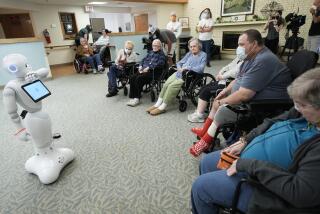Robots Ready to Be on Call for Disabled
- Share via
PHILADELPHIA — In K. G. Engelhardt’s kitchen, a robot raids the refrigerator, puts food in the microwave and makes coffee. All she has to do is ask.
One day, Engelhardt’s mechanical companion may help keep disabled and elderly people out of institutions. For now, it is languishing in a laboratory at Carnegie Mellon University’s Center for Human Service Robotics, where Engelhardt is the director.
The fully automated kitchen, one of several projects in various stages of development at the robotics center, is not designed as a luxury item for lazy homeowners.
“The idea is to increase the independence of older people and keep them out of (nursing) homes,” Engelhardt said recently at the Instrument Society of America’s annual conference.
The kitchen robot can perform 25 tasks, Engelhardt said, and responds to voice commands. In addition to cooking, it will take your medicine out of a cabinet and remind you to take it. It washes your fruit. It will even put cream and sugar in your coffee.
The robot performs its tasks with a white plastic hand that looks something like a clamp. The hand is connected to a black metallic arm that slides across the kitchen counter, from one appliance to the next, on a track.
“It’s color coordinated and looks more like a kitchen appliance than a robot,” Engelhardt said. “You don’t even know its there.”
Engelhardt sees robots playing an increasing role in health care and human services. She is in the process of testing the automated kitchen in the home of two elderly people, one a bedridden diabetic, the other in a wheelchair following a stroke.
But it will be awhile before others can benefit from the device. The problem is money. The robot system costs about $50,000, beyond the means of the people who need it the most.
Engelhardt hopes the government will come up with funding for additional robotics research and for programs that will offset the costs to the public. She said that of the $300 million spent by the federal government on robotic research last year, most went to defense and industrial applications.
Only recently has the robotics industry shown signs of emerging from a lengthy slump. The Robotic Industries Assn. reported that 1988 marked the first time in four years that new orders for robots increased. The $331 million in orders for last year was a 10% increase over 1987.
Engelhardt said the key to continued growth in the industry is humanization. For too long, she said, researchers have focused on building autonomous robots designed to replace humans.
“There’s a new era in which robots will augment and assist humans, not replace them,” she said.
With that in mind, researchers at the robotics center have developed an office robot that will help disabled workers with typing, filing and telephone chores.
The portable, automated office robot is voice activated and designed to do anything office workers would do with their arms or hands, said Engelhardt, who is quick to add that its primary purpose is to assist office workers with tedious chores.
The robot, which runs on a track across a three-section desk, consists of a black metal arm and a white plastic gripper and is covered by a plastic bubble. It can call anyone whose number is contained in its voice-activated directory. It can retrieve and replace files from its built-in filing cabinet. It can even destroy documents in its own paper shredder.
The robot responds to about 75 words but makes up for its lack of vocabulary with its looks.
“It’s really very beautiful,” Engelhardt said.
Like its kitchen cousin, the office robot will cost between $45,000 and $50,000. It is undergoing clinical testing, Engelhardt said, and could be introduced within six months.
Intervention Technologies, a firm associated with Carnegie Mellon, plans to manufacture the robot.
More to Read
Sign up for Essential California
The most important California stories and recommendations in your inbox every morning.
You may occasionally receive promotional content from the Los Angeles Times.










